The Minden Family
The Collection
The Collection consists of over 75 pieces of original ancient glass and pottery. The examples of glass date from the 6th century BC to the 12th century AD, thus covering a wide spectrum of glass making technology from its earliest beginnings in ancient Mesopotamia and Greece through to the middle ages. The pieces in the collection originate in the regions of Syria and Palestine, including the periods of Roman and Islamic occupation. The collection contains a variety of vessels that show developments in glass making techniques beginning in the ancient Near East. The earliest technique is called core forming which dates to the 10th century BC. In the 1st century BC, glass blowing and mould-made glass technologies were invented. The varying shapes and styles attest to the different functions of each piece. Many of the vessels in the collection were used as perfume vials, but there are others that were used as drinking and serving ware for special occasions. The collection also consists of a number of ancient glass and faience beads that were used as adornment. The Arthur and Beatrice Minden Collection of Glass occupies a prominent position in the Museum's growing collection of original ancient artefacts. Thanks to the generosity of donors like the Mindens, the Museum now boasts a substantial collection of ancient glass and pottery, much of it hailing from the ancient Near East. The breadth of the collection will serve faculty and students of the University of Saskatchewan by providing a valuable educational and research collection for advancing the study of ancient material culture.
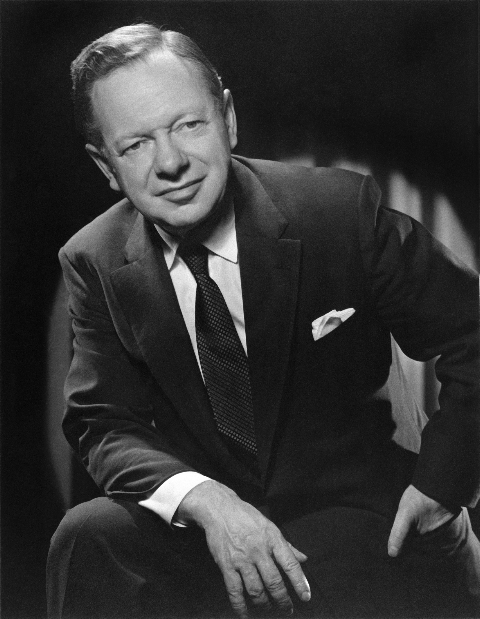

Core-Formed Glass
The earliest container glass vessels were of the core-formed type, which originated in New Kingdom Egypt and Mesopotamia around 1500 BC. The technique was later revived in Classical and Hellenistic Greece. It involved making a removable core of mud, clay or sand built up in the desired shape of the vessel around a metal rod. The core was then either dipped in molten glass or threads of hot glass were wound about it. The vessel was then rolled upon a flat surface to refine and smooth out the shape. Decorations, such as zigzags, were created by dragging a comb-like implement along the surface while it was still hot. Handles, necks, rims and feet were fused on separately. Finally, the core and metal rod were removed. The main shapes of core-formed vessels, including the alabastron (elongated flask), amphoriskos (small amphora), and the oinochoe (juglet), show Greek influence. Given their small size, the primary function of these vessels was likely to hold perfumes. The main centres for the production of these vessels were likely Egypt, Syria and Greece.
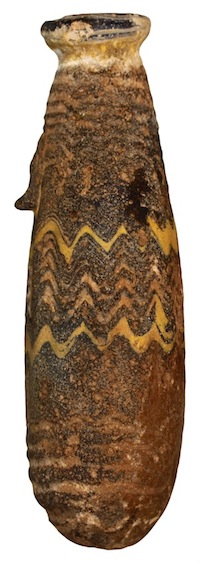
Alabastron
Syro-Palestinian
original
gift of: the Minden Family
date: c. 6th - 5th century BC
provenance: Syro-Palestine
description: Core-formed alabaston decorated with combed bands.
Blue, white and yellow glass.
Height: 11.5 cm
Diameter: 3.7 cm
Lip may be a replacement, overall wear, encrustation may hide damage to the body.
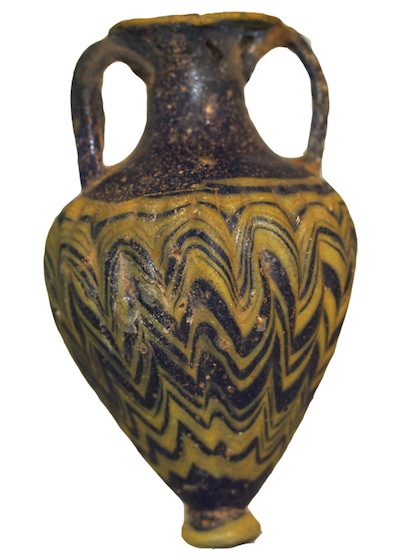
Amphoriskos
Mediterranean
original
gift of: the Minden Family
date: c. 6th - 5th century BC
provenance: Mediterranean
description: Twin-handled, core-formed amphoriskos with a ribbed body and decorated with tooled yellow threads.
Cobalt blue and yellow glass.
Height: 10 cm
Diameter: 6 cm
Portions of the lip and one handle restored.
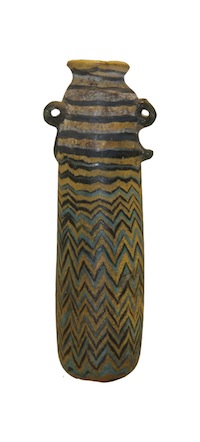
"Duck-Head" Alabastron
Syro-Palestinian
original
gift of: The Minden Family
date: c. 2nd half of 5th century BC
provenance: Syro-Palestine
description: Core-formed alabastron decorated with combed bands and "duck-head" terminals.
Black, turquoise, white and yellow glass.
Height: 8 cm
Diameter: 2.5 cm
Intact.
Islamic Glass
Glass production continued unabashed in the wake of the fall of the western Roman Empire in the 5th century AD, particularly in the east. Along with the rise of Islam came innovative styles, which flourished roughly from the 7th to the 14th centuries. Although indebted to glass-making techniques of late antiquity, Islamic glass artists introduced new shapes and new methods of decoration, including gilding and enameling of glass, methods that were later passed on to the Venetians. Islamic artists were also renowned for their superb relief-cut vessels.
A highlight of the Arthur and Beatrice Minden collection are several exquisite pieces of Islamic glass of late antiquity and the early middle ages. The earlier Islamic pieces were inspired by a Roman tradition of decorating clear, thin-walled vessels with fine spiraled and pinched threads. Late Islamic pieces, brilliantly coloured mold-blown vessels, remained in production into the early Middle Ages. Islamic vessels with globular bodies or round with flat bottoms attached to long, thin necks were popular as rose-water sprinklers. Such shapes were also popular in pottery manufacturing. Islamic cut glass is represented by a refined blue-green tubular bottle decorated with cut ovals inlaid in opaque white glass.
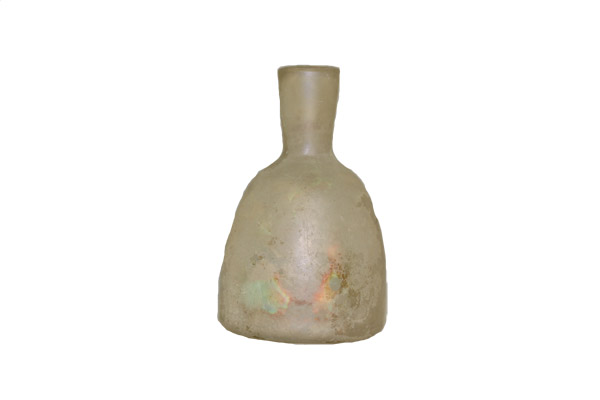
Bell Shaped Bottle
Syro-Palestinian or Egyptian
original
gift of: the Minden Family
date: c. AD 7th - 9th century

Bulbous Islamic Bottle
Islamic
original
gift of: the Minden Family
date: c. AD 11th - 12th century
provenance: Syro-Palestine.
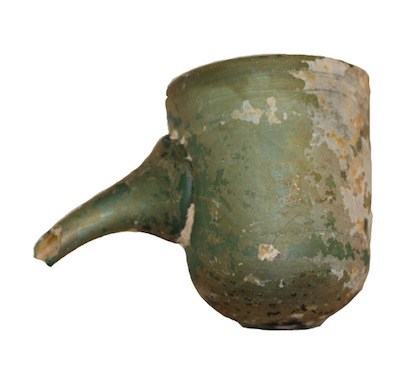
Cupping Glass
Islamic
original
gift of: the Minden Family
date: c. 9th - 14th century AD
provenance: Syro-Palestine
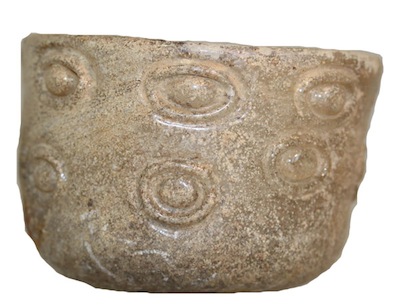
Eye Jar
Islamic
original
gift of: the Minden Family
date: c. 9th - 10th century AD
provenance: Persia, possibly Egypt

Islamic Bottle
Islamic
original
gift of: the Minden Family
date: c. 11th - 12th century AD
provenance: Syro-Palestine or Iran
description: Tall, thin-necked bottle with a tulip-shaped mouth. There is an approximate 5 mm interior flange running through the mid-point of the bulbous body and three bands of applied decoration to the neck: the lower band a thick, pinched dark blue; the mid-point in a three twist trailed decoration in the same colour as the body; the upper in dark blue trail with a cage in turquoise blue applied over.
Greenish glass, dark blue and turquoise appliqués as noted.
Height: 19 cm
Diameter: 9.5 cm
Small hole to the body repaired, spreading fractures from the hole are stable, trace encrustation, old collection label to the base.

Blue Bottle
Islamic
original
gift of: the Minden Family
date: c. AD 11th - 12 century
provenance: Egypt or Persia
description: Height: 18 cm
Diameter: 9 cm
Greenish glass, dark blue and turquoise appliqués as noted.
Height: 19 cm
Diameter: 9.5 cm
Small hole to the body repaired, spreading fractures from the hole are stable, trace encrustation, old collection label to the base.
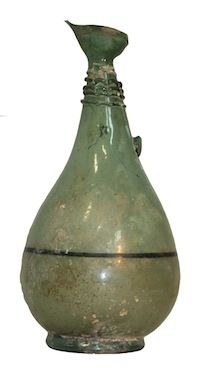
Islamic Decanter (Ewer)
Islamic
original
gift of: the Minden Family
date: c. 7th - 9th century AD
provenance: Syro-Palestine or Iran
Handle is fugitive, small hole to the body repaired, spreading fractures from the hole are stable, trace encrustation, old collection label to the base.

Islamic Square Bodied Bottle
Islamic
original
gift of: the Minden Family
date: c. 7th - 12th century AD
provenance: Syro-Palestine or Iran
description: Square-bodied bottle with a pinched flower-like lip and a side lug.
Dark blue glass.
Height: 7.5 cm
Width: 2.7 cm
Intact, nice iridescence.
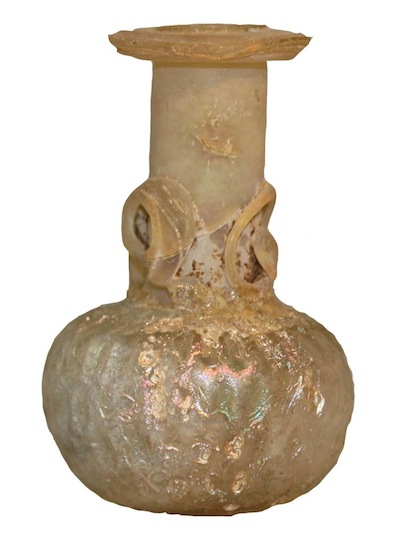
Squat Islamic Bottle
Islamic
original
gift of: the Minden Family
date: c. 4th - 9th century AD
provenance: Syro-Palestine
description: Squat bottle dimpled body and applied decoration to the neck.
Yellowish glass.
Height: 6 cm
Diameter: 5 cm
A pastiche the base being Islamic and the neck belonging to another vase, iridescence.

Thick Necked Islamic Bottle
Islamic
original
gift of: the Minden Family
date: c. 9th-10th century AD
provenance: Syro-Palestine or Iran
description: height: 20.5 cm
diameter: 9.5 cm

Tubular Bottle
Islamic
original
gift of: the Minden Family
date: c. 7th - 8th century AD
provenance: Persia
description: Bottle decorated with ground dimples inlaid with white open ovals.
Blue-green and white glass.
Height: 16.5 cm
Diameter: 3 cm

Wide Bottle
Islamic
original
gift of: the Minden Family
date: c. 17th century AD
provenance: Syro-Palestine or Iran
description: Wide shaped bottle with circle decoration at the top of body. Shallow "steps".
Green/Blue glass.
Height: 20.5 cm
Diameter: 9.5 cm
Perfume Vessels

Date Flask
Syro-Palestinian
original
gift of: the Minden Family
date: c. mid 1st - early 2nd century AD
provenance: Syro-Palestine
description: Mold-blown flask in the form of a date with a short neck and flared rim.
Amber glass.
Height: 8.5 cm
Diameter: 3.1 cm
Intact, iridescence.
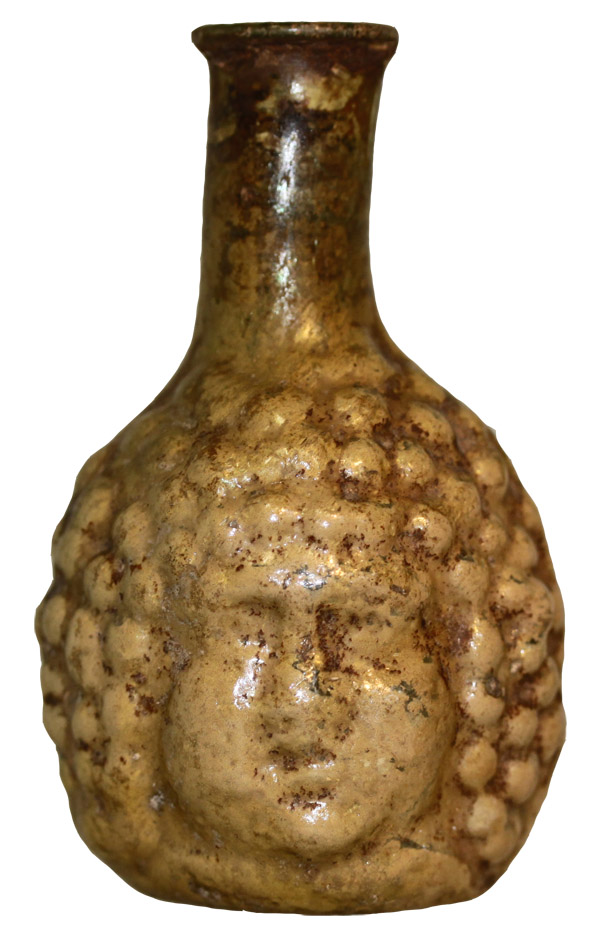
Janus Flask
Syro-Palestinian
original
gift of: the Minden Family
date: c. 3rd - 4th century AD
provenance: Syro-Palestine
description: Mold-blown "Janus" flask.
Height: 8 cm
Diameter: 5 cm
Intact, some iridescence.
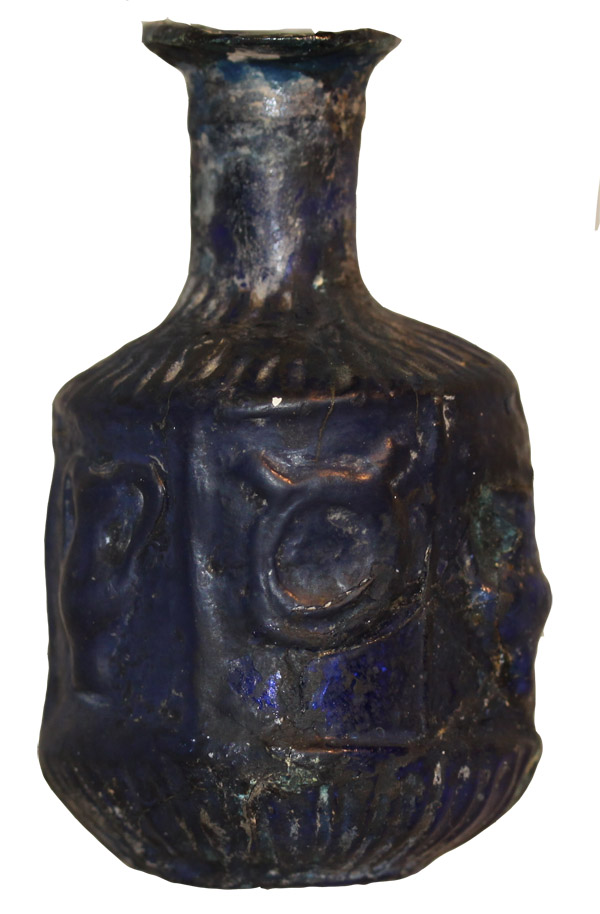
Sidonian Flask
Syro-Palestinian
original
gift of: the Minden Family
date: c. 1st century AD
provenance: Syro-Palestine
description: Sidonian mold-blown hexagonal flask decorated with vases, crosses and other motives, the shoulder and base ribbed.
Dark blue glass.
Height: 8.5 cm
Diameter: 5.7 cm
The body and shoulder show restoration, trace iridescence and encrustation.
Amphora Shaped Unguentaria
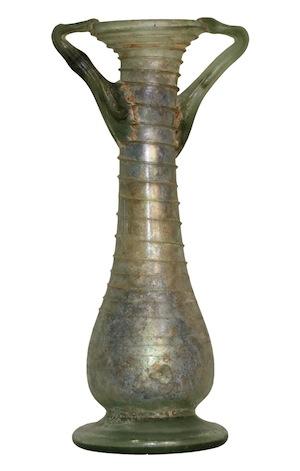
Cosmetic Flask
Syro-Palestinian
original
gift of: the Minden Family
date: c. 4th century AD
provenance: Syro-Palestine
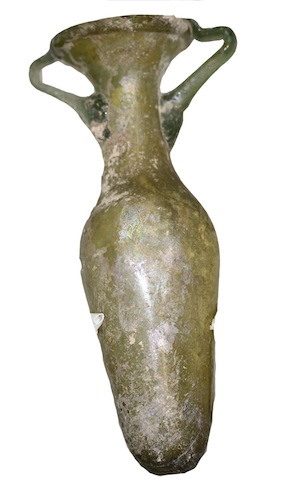
Perfume Bottle
Syro-Palestinian
original
gift of: the Minden Family
date: c. 4th century AD
provenance: Syro-Palestine
description: Perfume bottle with cone-shaped, dimpled body, tall cylindrical neck, spread lip and twin handles.
Green glass.
Height: 13 cm
Width: 6.5 cm
Intact, iridescence and encrustation, number "105" in red to the base.
Bulb Shaped Unguentaria

Bulbous Bottle
Syro-Palestinian
original
gift of: the Minden Family
date: c. 1st century AD
provenance: Syro-Palestine
description: Thin-necked bottle witha bulbous base and flat lip.
Pale green glass.
Height: 7 cm
Diameter: 3.5 cm
Lip broken in two places, some iridescence encrustation and a rolled up paper inside.
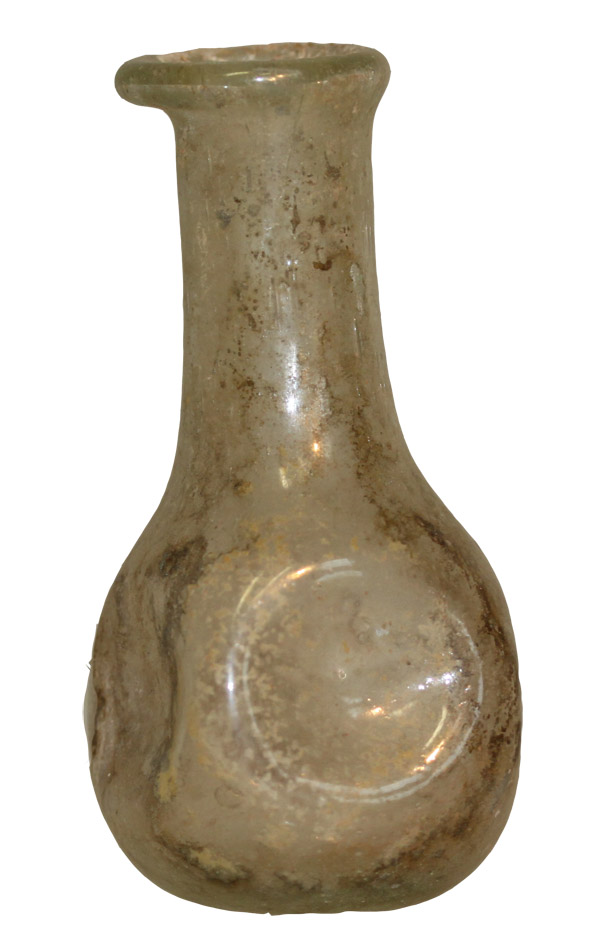
Dimpled Perfume Bottle
Syro-Palestinian
original
gift of: the Minden Family
date: c. 2nd century AD
provenance: Syro-Palestine
description: Perfume bottle with a dimpled body, cylindrical neck and flat lip.
Clear glass.
Height: 6.5 cm
Diameter: 3.5 cm
Intact, some iridescence and encrustation.

Four Handled Jar
Syro-Palestinian
original
gift of: the Minden Family
date: Contemporary, probably from the Hebron area, mirroring a correct ancient shape of the 4th century AD
provenance: Syro-Palestine
description: Jar with bag-shaped body, expanded neck and four applied handles.
Cobalt blue glass.
Height: 6.8 cm
Diameter: 5 cm
Intact, label to the base.

Pear Shaped Perfume Bottle
Syro-Palestinian
original
gift of: the Minden Family
date: c. 1st century AD
provenance: Syro-Palestine
Candle Stick Unguentaria
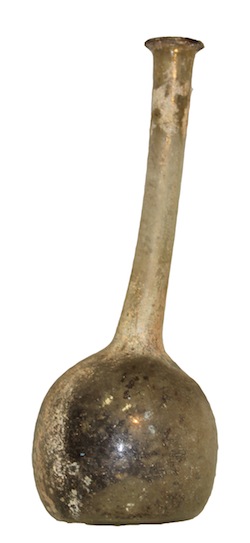
Candlestick Bottle
Syro-Palestinian
original
gift of: the Minden Family
date: c. 1st century AD
provenance: Syro-Palestine
description: Tall, thin-necked bottle of candlestick form with a bulbous base.
Colorless; Pale blue; Pale green glass.
Height: 15.5 cm
Diameter: 6 cm
Intact, lip restored, some iridescence.

Candlestick Unguentarium II
Syro-Palestinian
original
gift of: the Minden Family
date: c. 2nd - 3rd century AD
provenance: Syro-Palestine
description: Candlestick unguentarium.
Pale blue-green glass.
Height: 16.5 cm
Diameter 7.5 cm
Intact, some iridescence.
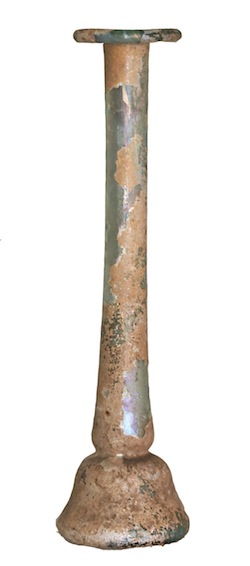
Candlestick Unguentarium
Syro-Palestinian
original
gift of: the Minden Family
date: c. 2nd - 3rd century AD
provenance: Syro-Palestine
description: Candlestick bottle.
Pale blue-green glass.
Intact, nice iridescence, two paper labels to the base.
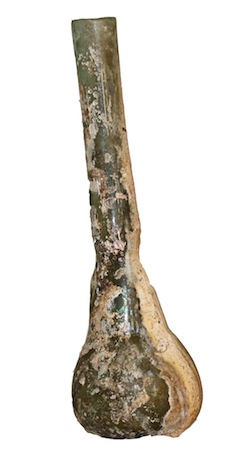
Globular Unguetarium
Syro-Palestinian
original
gift of: the Minden Family
date: c. 1st - 2nd century AD
provenance: Syro-Palestine
description: Perfume bottle with globular body, tall cylindrical neck.
Green glass.
Lip is fugitive, iridescence and encrustation showing how the bottle was buried.
Sprinklers
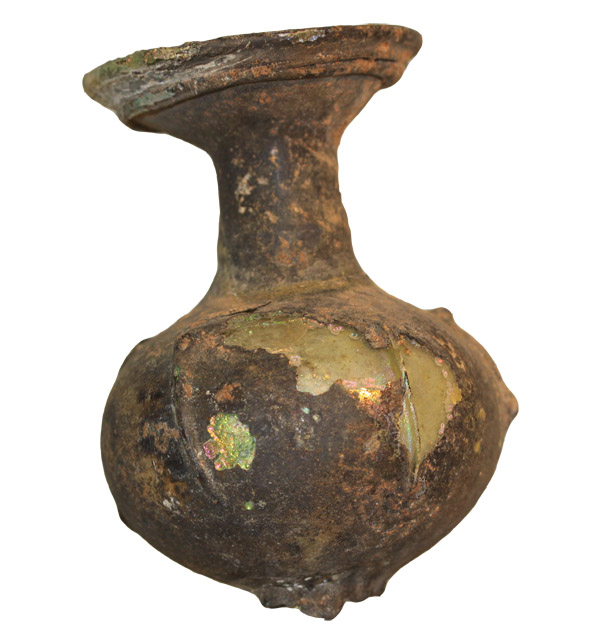
Dropper Flask
Syro-Palestinian
original
gift of: the Minden Family
date: c. 4th century AD
provenance: Syro-Palestine

Dropper Flask
Syro-Palestinian
original
gift of: the Minden Family
date: c. 3rd - 4th century AD
provenance: Syro-Palestine
description: Dropper flask with a ribbed, pear-shaped body, pinched feet and a spread lip with trailed decoration to the underside.
Olive green glass.
Height: 10 cm
Diameter: 6.6 cm
Intact, single slight crack, trace iridescence and encrustation.

Sprinkler
Israel
original
gift of: the Minden Family
date: c. AD 4th - 5th century
provenance: Israel
Squat Form Unguentaria

Dropper Bottle
Syro-Palestinian
original
gift of: the Minden Family
date: c. 1st century AD
provenance: Syro-Palestine
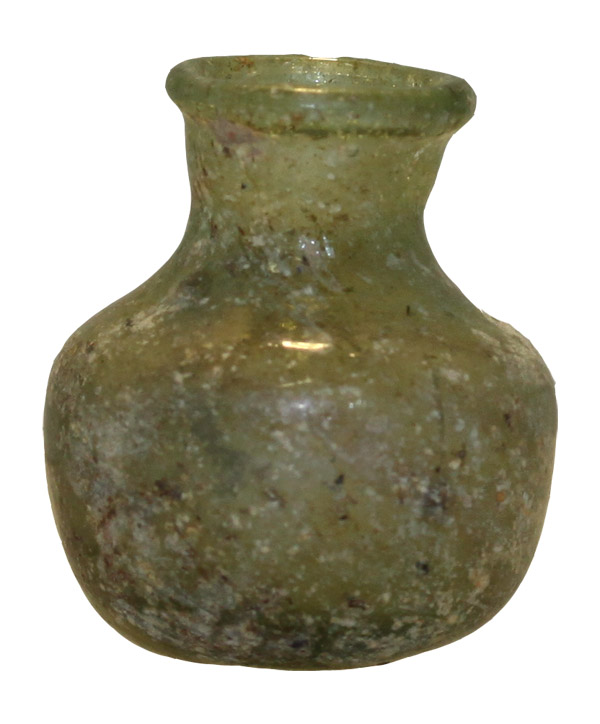
Miniature Globular Jar
Syro-Palestinian
original
gift of: the Minden Family
date: c. 1st - 2nd century AD
provenance: Syro-Palestine
description: Miniature jar of globular form.
Pale green glass.
Height: 3.2 cm
Diameter: 3 cm
Intact, encrustation.
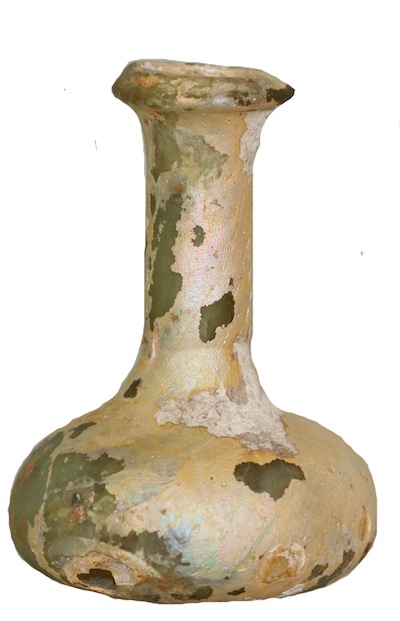
Perfume Bottle
Syro-Palestinian
original
gift of: the Minden Family
date: c. 1st - 2nd century AD
provenance: Syro-Palestine
description: Perfume bottle with a spread base, cylindrical neck and disk-shaped rim.
Pale green glass.
Height: 8.5 cm
Diameter: 6 cm
1.5 cm hole to the base, iridescence and trace encrustation.
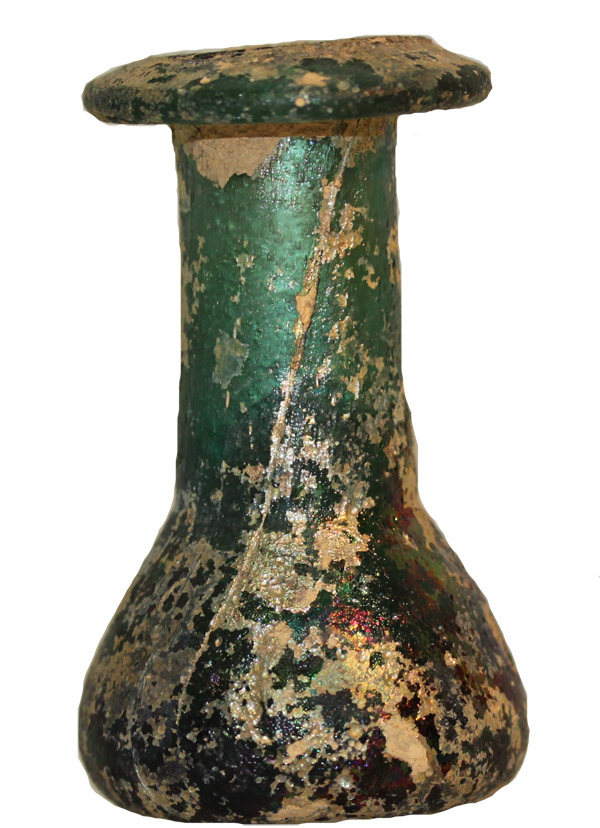
Pillar Unguentarium
Syro-Palestine
original
gift of: the Minden Family
date: c. 1st - 2nd century AD
provenance: Syro-Palestine
description: Squat "pillar" unguentarium.
Dark green glass.
Height: 6.5 cm
Diameter: 3 cm
Intact, nice iridescence.
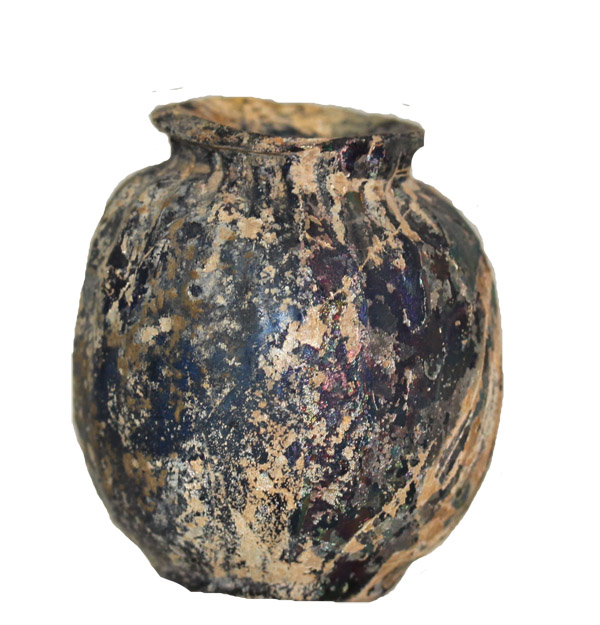
Poppy Jar
Syro-Palestine
original
gift of: the Minden Family
date: c. 3rd - 4th century AD
provenance: Syro-Palestine.
Tubular Unguentaria

Double Unguentarium
Syro-Palestine
original
gift of: the Minden Family
date: c. 4th - 5th century AD
provenance: Syro-Palestine.
description: Double unguentarium with open ribbon decoration to the sides.
Green glass.
Intact, minor encrustation.

Double Unguentarium with Twin Handles
Syro-Palestinian
original
gift of: the Minden Family
date: c. 4th - 5th century AD
provenance: Syro-Palestine
description: Double unguentarium with twin handles.
Pale blue-green glass.
Height: 12 cm
Width: 4 cm
Intact, iridescence, encrustation, number "162" in red to the base.
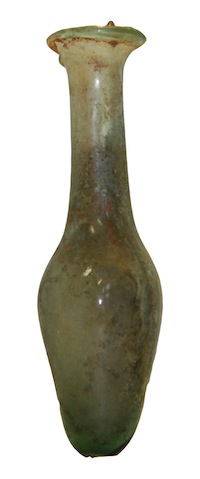
Unguentarium
Syro-Palestinian
original
gift of: the Minden Family
date: c. 1st century AD
provenance: Syro-Palestine
description: Amphoriskos with a round base, cylindrical neck and disk-shaped rim. Intact, iridescence and trace encrustation, lavel to the side.
Slag Glass
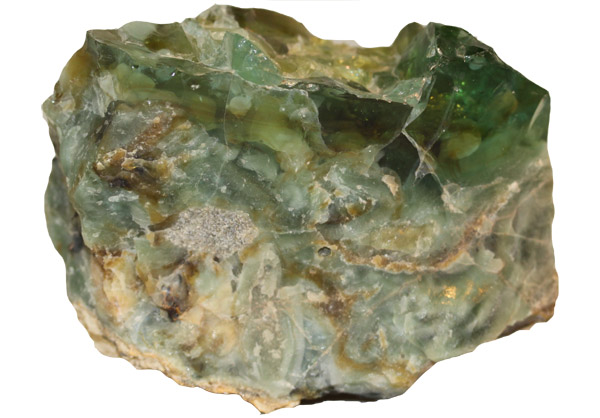
Slag Glass
Syro-Palestinian
original
gift of: the Minden Family
date: c. 1st - 12th century AD
provenance: Syro-Palestine